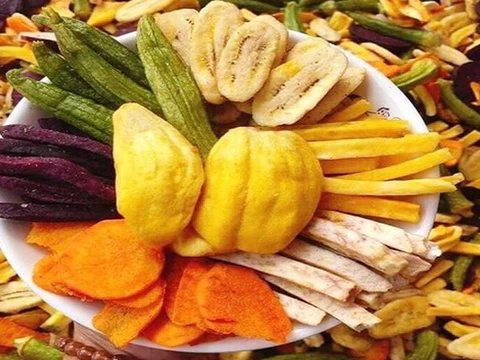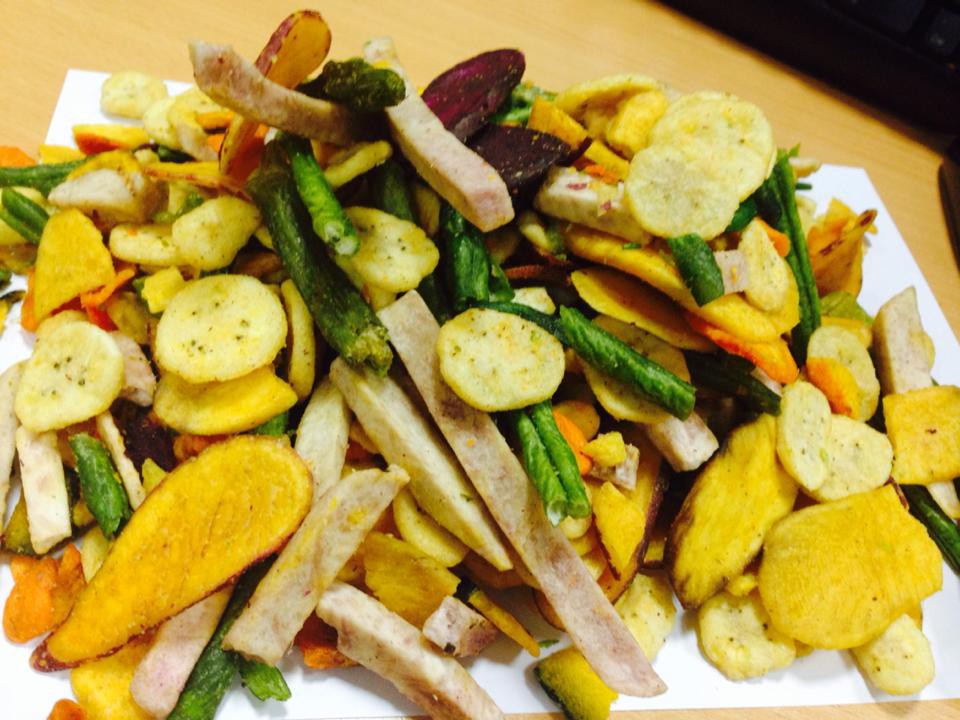
Dried vegetables and fruits are among the processed agricultural products that are strongly asserting Vietnam’s position in the international market. Processed from an abundance of fresh, high-quality produce, Vietnamese dried vegetables and fruits are not only an excellent preservation solution but also a convenient, nutrient-rich snack, perfectly aligning with the global trend toward healthy and convenient food consumption.
1. Origin and Product Diversity
Vietnam’s favorable land and climate provide a rich source of raw vegetables and fruits, forming the foundation for a thriving drying industry.
- Select Raw Materials: The most popular vegetables and fruits used include sweet potato (purple, yellow, honey), taro, carrot, pumpkin, and green beans. These ingredients are grown in specialized regions like Dalat (Lam Dong) and the Mekong Delta, ensuring freshness, natural sweetness, and high nutritional value.
- Diverse Processing Technologies: Vietnam’s drying industry utilizes several advanced technologies to create product lines that cater to global preferences:
- Vacuum Frying: The primary technology, creating crispy dried vegetables and fruits (chips/crisps) like dried jackfruit or crispy sweet potato. Frying at low pressure and temperature significantly reduces oil content (30-50%), preserving natural color and a crunchy texture.
- Soft Drying: Commonly used for products like soft-dried sweet potato, resulting in a chewy, soft texture and rich sweetness.
- Freeze Drying: A high-end method that preserves the shape and most of the nutrition (e.g., freeze-dried cabbage, peas), often used as an ingredient for instant soups or premium snacks.

2. Nutritional Value and Export Benefits
Dried vegetables and fruits are a smart choice for modern consumers due due to their concentrated nutritional value.
- Concentrated Nutrition: The drying process helps retain a maximum amount of Vitamins (A, C), Fiber, and Minerals in the produce. The products are a rich source of natural energy and antioxidants.
- Healthy Snack Option: Considered a healthy alternative to traditional potato chips, aligning with the global Plant-based and Clean Eating trends.
- Convenience and Safety: Products are lightweight, have a long shelf life, and are easy to transport and distribute. Vietnamese businesses guarantee products are free of preservatives, artificial colors, and flavors.
3. Production Process and Quality Standards
Vietnamese dried vegetables and fruits are manufactured under strict procedures, meeting the highest international quality standards.
- Input Control: Raw materials are harvested at the right time, ensuring freshness and checked for pesticide residue before processing.
- Closed Processing Line: From preliminary cleaning and cutting to drying and packaging, all steps are carried out in a hygiene-controlled environment.
- Export Standards: Products comply with international certifications such as HACCP, ISO 22000, and GlobalGAP, ensuring clear traceability and absolute safety for consumers in the U.S., EU, Japan, and South Korea.
4. Development Potential and Global Standing
Vietnamese dried vegetables and fruits have great prospects thanks to product flexibility and quality.
- Competitive Advantage: The ability to supply a variety of products (from crispy and soft-dried to freeze-dried) with competitive pricing and stable quality is a major benefit.
- Product Innovation: Companies are continuously researching to launch mixed dried vegetable and fruit products, meeting the demand for diverse and convenient snacking options.
Vietnamese dried vegetables and fruits are a testament to the strong development of the processed agricultural sector. This product is not only a nutritious gift from the motherland but also an ambassador of quality, asserting the brand of Vietnamese agricultural products in the global market.
Other articles:
Other agricultural products:

